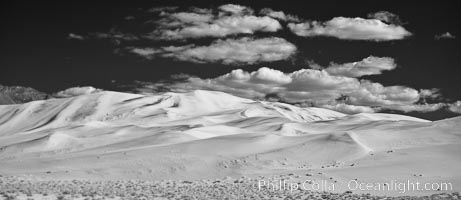
Eureka Dunes. The Eureka Dunes are California's tallest sand dunes, and one of the tallest in the United States. Rising 680' above the floor of the Eureka Valley, the Eureka sand dunes are home to several endangered species, as well as "singing sand" that makes strange sounds when it shifts.
Location: Eureka Dunes, Death Valley National Park, California
Image ID: 25387
Location: Eureka Dunes, Death Valley National Park, California
Image ID: 25387
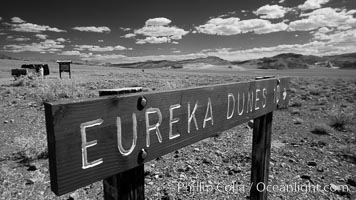
Sign to Eureka Dunes and Eureka Valley.
Location: Eureka Valley, Death Valley National Park, California
Image ID: 25389
Location: Eureka Valley, Death Valley National Park, California
Image ID: 25389

Panorama of the Racetrack at Death Valley.
Location: Racetrack Playa, Death Valley National Park, California
Image ID: 27686
Panorama dimensions: 2831 x 15932
Location: Racetrack Playa, Death Valley National Park, California
Image ID: 27686
Panorama dimensions: 2831 x 15932

Zabriskie Point sunrise, clouds blurred by long time exposure, Death Valley National Park, California.
Location: Zabriskie Point, Death Valley National Park, California
Image ID: 27655
Location: Zabriskie Point, Death Valley National Park, California
Image ID: 27655

Zodiacal light and Milky Way over Death Valley. Zodiacal light is a faint diffuse light seen along the plane of the ecliptic in the vicinity of the setting or rising sun, caused by sunlight scattered off space dust in the zodiacal cloud.
Location: Racetrack Playa, Death Valley National Park, California
Image ID: 27693
Location: Racetrack Playa, Death Valley National Park, California
Image ID: 27693
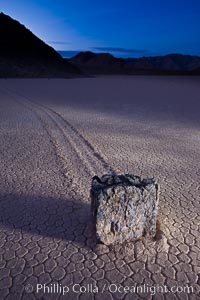
Sunrise on the Racetrack Playa. The sliding rocks, or sailing stones, move across the mud flats of the Racetrack Playa, leaving trails behind in the mud. The explanation for their movement is not known with certainty, but many believe wind pushes the rocks over wet and perhaps icy mud in winter.
Location: Racetrack Playa, Death Valley National Park, California
Image ID: 27696
Location: Racetrack Playa, Death Valley National Park, California
Image ID: 27696

Eureka Valley Dune Evening Primrose. A federally endangered plant, Oenothera californica eurekensis is a perennial herb that produces white flowers from April to June. These flowers turn red as they age. The Eureka Dunes evening-primrose is found only in the southern portion of Eureka Valley Sand Dunes system in Indigo County, California.
Species: Eureka valley dune evening primrose, Oenothera californica eurekensis, Oenothera deltoides
Location: Eureka Dunes, Death Valley National Park, California
Image ID: 25268
Species: Eureka valley dune evening primrose, Oenothera californica eurekensis, Oenothera deltoides
Location: Eureka Dunes, Death Valley National Park, California
Image ID: 25268

Eureka Valley Dune Evening Primrose. A federally endangered plant, Oenothera californica eurekensis is a perennial herb that produces white flowers from April to June. These flowers turn red as they age. The Eureka Dunes evening-primrose is found only in the southern portion of Eureka Valley Sand Dunes system in Indigo County, California.
Species: Eureka valley dune evening primrose, Oenothera californica eurekensis, Oenothera deltoides
Location: Eureka Dunes, Death Valley National Park, California
Image ID: 25341
Species: Eureka valley dune evening primrose, Oenothera californica eurekensis, Oenothera deltoides
Location: Eureka Dunes, Death Valley National Park, California
Image ID: 25341
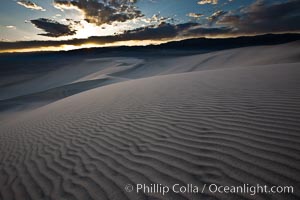
Sunset on the Eureka Dunes. The Eureka Valley Sand Dunes are California's tallest sand dunes, and one of the tallest in the United States. Rising 680' above the floor of the Eureka Valley, the Eureka sand dunes are home to several endangered species, as well as "singing sand" that makes strange sounds when it shifts. Located in the remote northern portion of Death Valley National Park, the Eureka Dunes see very few visitors.
Location: Eureka Dunes, Death Valley National Park, California
Image ID: 25352
Location: Eureka Dunes, Death Valley National Park, California
Image ID: 25352

Sunset on the Eureka Dunes. The Eureka Valley Sand Dunes are California's tallest sand dunes, and one of the tallest in the United States. Rising 680' above the floor of the Eureka Valley, the Eureka sand dunes are home to several endangered species, as well as "singing sand" that makes strange sounds when it shifts. Located in the remote northern portion of Death Valley National Park, the Eureka Dunes see very few visitors.
Location: Eureka Dunes, Death Valley National Park, California
Image ID: 25353
Location: Eureka Dunes, Death Valley National Park, California
Image ID: 25353

Sunrise lights Telescope Peak as it rises over the salt flats of Badwater, Death Valley. At 11,049 feet, Telescope Peak is the highest peak in the Panamint Range as well as the highest point in Death Valley National Park. At 282 feet below sea level, Badwater is the lowest point in North America.
Location: Badwater, Death Valley National Park, California
Image ID: 20549
Location: Badwater, Death Valley National Park, California
Image ID: 20549
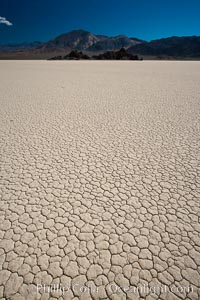
Racetrack Playa, an ancient lake now dried and covered with dessicated mud.
Location: Racetrack Playa, Death Valley National Park, California
Image ID: 25316
Location: Racetrack Playa, Death Valley National Park, California
Image ID: 25316

A sliding rock of the Racetrack Playa. The sliding rocks, or sailing stones, move across the mud flats of the Racetrack Playa, leaving trails behind in the mud. The explanation for their movement is not known with certainty, but many believe wind pushes the rocks over wet and perhaps icy mud in winter.
Location: Racetrack Playa, Death Valley National Park, California
Image ID: 25322
Location: Racetrack Playa, Death Valley National Park, California
Image ID: 25322

Sailing stone on the Death Valley Racetrack playa. The sliding rocks, or sailing stones, move across the mud flats of the Racetrack Playa, leaving trails behind in the mud. The explanation for their movement is not known with certainty, but many believe wind pushes the rocks over wet and perhaps icy mud in winter.
Location: Racetrack Playa, Death Valley National Park, California
Image ID: 25324
Location: Racetrack Playa, Death Valley National Park, California
Image ID: 25324

Sailing stone on the Death Valley Racetrack playa. The sliding rocks, or sailing stones, move across the mud flats of the Racetrack Playa, leaving trails behind in the mud. The explanation for their movement is not known with certainty, but many believe wind pushes the rocks over wet and perhaps icy mud in winter.
Location: Racetrack Playa, Death Valley National Park, California
Image ID: 25327
Location: Racetrack Playa, Death Valley National Park, California
Image ID: 25327

Sailing stone on the Death Valley Racetrack playa. The sliding rocks, or sailing stones, move across the mud flats of the Racetrack Playa, leaving trails behind in the mud. The explanation for their movement is not known with certainty, but many believe wind pushes the rocks over wet and perhaps icy mud in winter.
Location: Racetrack Playa, Death Valley National Park, California
Image ID: 25331
Location: Racetrack Playa, Death Valley National Park, California
Image ID: 25331

A sliding rock of the Racetrack Playa. The sliding rocks, or sailing stones, move across the mud flats of the Racetrack Playa, leaving trails behind in the mud. The explanation for their movement is not known with certainty, but many believe wind pushes the rocks over wet and perhaps icy mud in winter.
Location: Racetrack Playa, Death Valley National Park, California
Image ID: 25332
Location: Racetrack Playa, Death Valley National Park, California
Image ID: 25332

Eureka Dunes. The Eureka Valley Sand Dunes are California's tallest sand dunes, and one of the tallest in the United States. Rising 680' above the floor of the Eureka Valley, the Eureka sand dunes are home to several endangered species, as well as "singing sand" that makes strange sounds when it shifts. Located in the remote northern portion of Death Valley National Park, the Eureka Dunes see very few visitors.
Location: Eureka Dunes, Death Valley National Park, California
Image ID: 25375
Location: Eureka Dunes, Death Valley National Park, California
Image ID: 25375

The Grandstand, standing above dried mud flats, on the Racetrack Playa in Death Valley.
Location: Racetrack Playa, Death Valley National Park, California
Image ID: 25317
Location: Racetrack Playa, Death Valley National Park, California
Image ID: 25317
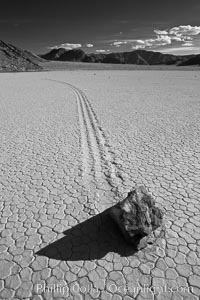
Sailing stone on the Death Valley Racetrack playa. The sliding rocks, or sailing stones, move across the mud flats of the Racetrack Playa, leaving trails behind in the mud. The explanation for their movement is not known with certainty, but many believe wind pushes the rocks over wet and perhaps icy mud in winter.
Location: Racetrack Playa, Death Valley National Park, California
Image ID: 25333
Location: Racetrack Playa, Death Valley National Park, California
Image ID: 25333

Devils Golf Course, California. Evaporated salt has formed into gnarled, complex crystalline shapes in on the salt pan of Death Valley National Park, one of the largest salt pans in the world. The shapes are constantly evolving as occasional floods submerge the salt concretions before receding and depositing more salt.
Location: Devils Golf Course, Death Valley National Park, California
Image ID: 15582
Location: Devils Golf Course, Death Valley National Park, California
Image ID: 15582

Racetrack Playa, an ancient lake now dried and covered with dessicated mud.
Location: Racetrack Playa, Death Valley National Park, California
Image ID: 26385
Location: Racetrack Playa, Death Valley National Park, California
Image ID: 26385

Salt polygons. After winter flooding, the salt on the Badwater Basin playa dries into geometric polygonal shapes.
Location: Badwater, Death Valley National Park, California
Image ID: 27635
Location: Badwater, Death Valley National Park, California
Image ID: 27635

Darwin Falls in Death Valley, near the settlement of Panamint Springs. The falls are fed by a perennial stream that flows through a narrow canyon of plutonic rock, and drop of total of 80' (24m) in two sections.
Location: Darwin Falls, Death Valley National Park, California
Image ID: 27684
Location: Darwin Falls, Death Valley National Park, California
Image ID: 27684

Darwin Falls in Death Valley, near the settlement of Panamint Springs. The falls are fed by a perennial stream that flows through a narrow canyon of plutonic rock, and drop of total of 80' (24m) in two sections.
Location: Darwin Falls, Death Valley National Park, California
Image ID: 27685
Location: Darwin Falls, Death Valley National Park, California
Image ID: 27685

Eureka Dunes. The Eureka Valley Sand Dunes are California's tallest sand dunes, and one of the tallest in the United States. Rising 680' above the floor of the Eureka Valley, the Eureka sand dunes are home to several endangered species, as well as "singing sand" that makes strange sounds when it shifts. Located in the remote northern portion of Death Valley National Park, the Eureka Dunes see very few visitors.
Location: Eureka Dunes, Death Valley National Park, California
Image ID: 26383
Location: Eureka Dunes, Death Valley National Park, California
Image ID: 26383

Eureka Dunes. The Eureka Valley Sand Dunes are California's tallest sand dunes, and one of the tallest in the United States. Rising 680' above the floor of the Eureka Valley, the Eureka sand dunes are home to several endangered species, as well as "singing sand" that makes strange sounds when it shifts. Located in the remote northern portion of Death Valley National Park, the Eureka Dunes see very few visitors.
Location: Eureka Dunes, Death Valley National Park, California
Image ID: 26384
Location: Eureka Dunes, Death Valley National Park, California
Image ID: 26384

Sunrise at Zabriskie Point, Manly Beacon is lit by the morning sun while dark clouds lie on the horizon.
Location: Zabriskie Point, Death Valley National Park, California
Image ID: 26386
Location: Zabriskie Point, Death Valley National Park, California
Image ID: 26386

Salt polygons. After winter flooding, the salt on the Badwater Basin playa dries into geometric polygonal shapes.
Location: Badwater, Death Valley National Park, California
Image ID: 27632
Location: Badwater, Death Valley National Park, California
Image ID: 27632

Salt polygons. After winter flooding, the salt on the Badwater Basin playa dries into geometric polygonal shapes.
Location: Badwater, Death Valley National Park, California
Image ID: 27633
Location: Badwater, Death Valley National Park, California
Image ID: 27633